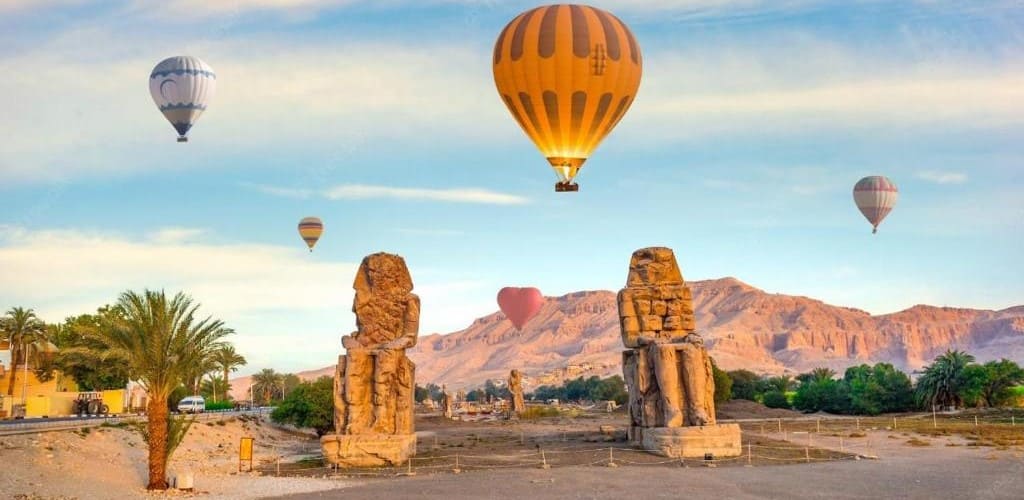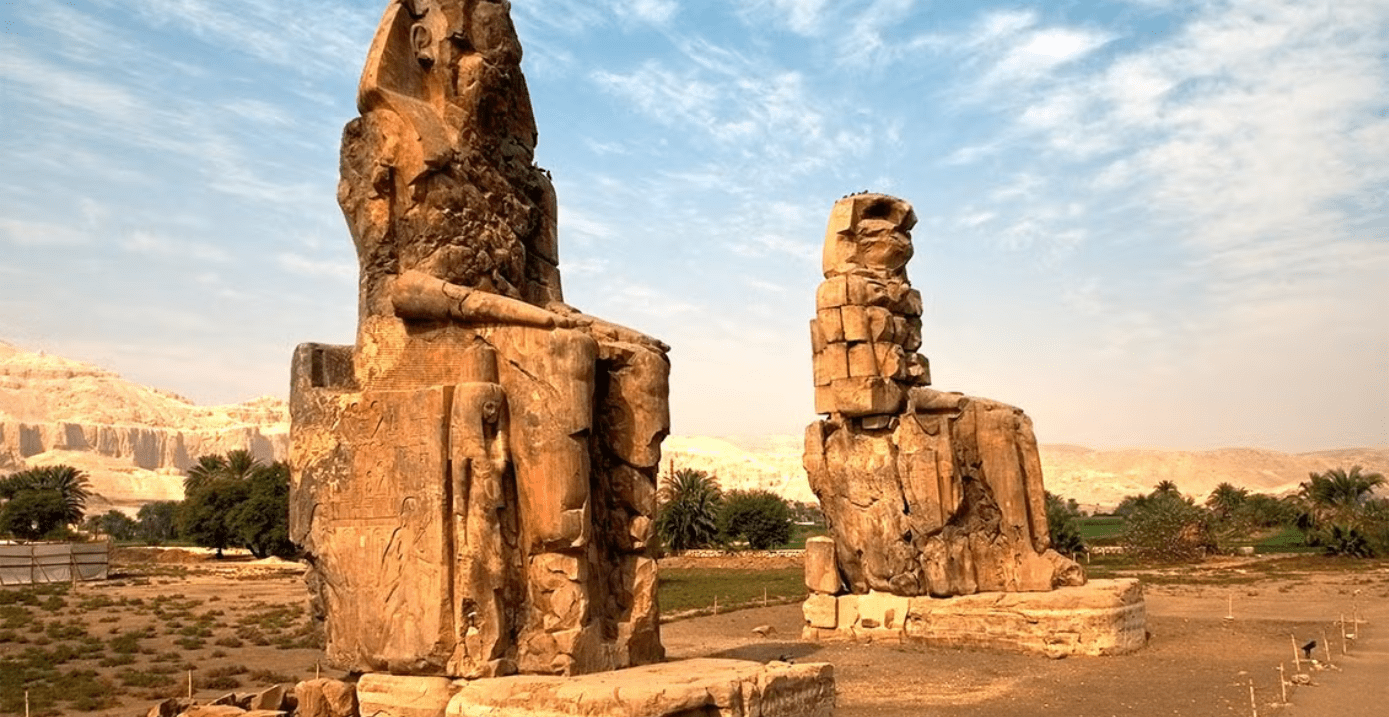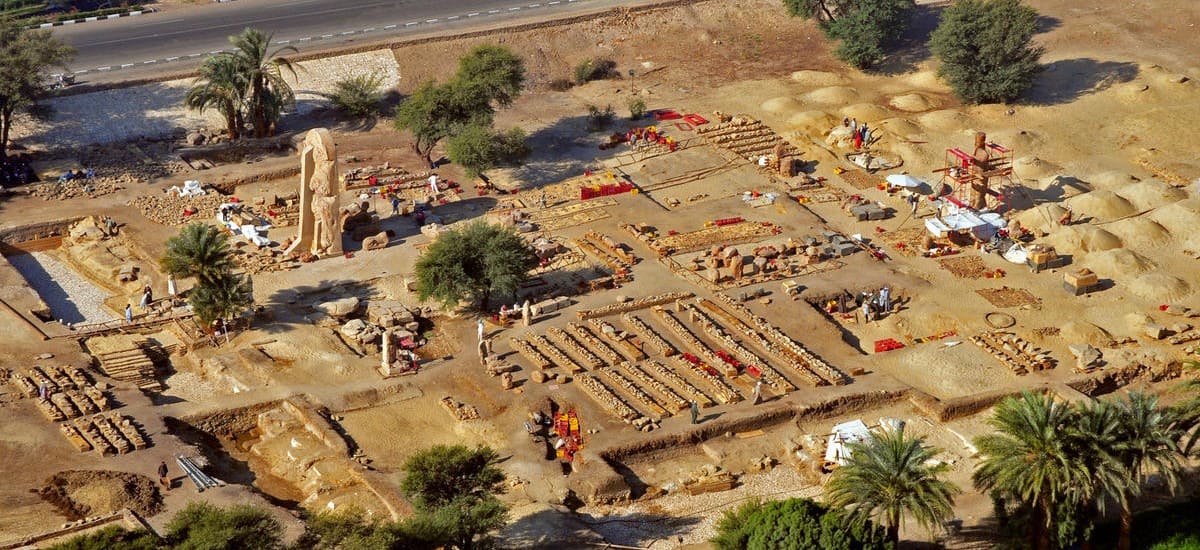The Colossi of Memnon: Guardians of Ancient Thebes
Luxor City is the hosting home for most of the pharaonic Egyptian monuments. It was the chosen city by ancient Egyptian kings to be settled for their temples and tombs commemorating statues. Among them are the Colossi of Memnon. They are two massive monumental statues that belong to King Amenhotep III from the 18th dynasty.
The Colossi of Memnon is located west of the modern city of Luxor and faces east, looking toward the Nile River. They are the first monuments most travelers see on the West Bank. They were named after the Greek hero Memnon, who was an Ethiopian king and was killed in a battle by Achilles. His name was used to dedicate his memory by calling the two statues of Amenhotep III after collecting the parts of the statue once more as in 27 BC, an earthquake shattered the two colossi and they had to be gathered together again.

The Colossi of Memnon is believed to have been so popular during the Roman period because it is said that the statues sang. An earthquake damaged it and began producing at sunrise a “musical” sound. Some Greek visitors associated it with the mythological Memnon calling to his mother Aurora, the goddess of the morning sun. But this was probably due to the expansion of the stone, which warmed up during the day and cooled off at night. Another theory suggests that the reverberating wind through the cracks made the sounds. However, the restoration that occurred in 199 BC stopped the sounds from happening, and the statues never sang again.
The two massive statues of Amenhotep III were built as guardians for Amenhotep’s mortuary complex in Luxor. Some natural disasters, including earthquakes, floods, and other events, led to the disappearance of the whole complex in addition to the fact that Ancient Egyptians used some of the monuments of the complex to build other attractions.
The Description of Colossi of Memnon

Colossi of Memnon are 18 meters high, and each one of them weighs 720 tons. The sphinx was carved from single blocks of sandstone and believed to have been quarried near Giza, then transported about 420 miles (675 km) south to Thebes overland.
They are two-seated king statues on a throne ornamented, representing the pharaoh wearing the royal headdress of the Nemes, protected by the divine cobra. The hands of the king are resting on his knees. And he directs his face towards the east looking at the Nile River. The base of the two statues depicts the mother of Amenhotep III, “Mutemwiya” and his wife “Tiye” on the front and “Hapy”, the god of the Nile, on the side, and all of the three symbolize rebirth. The two statues are much damaged since 27 BC, but they remain symbols of the amazing Egyptian Civilization and culture.
The South Colossus is better preserved than the one to the north. It stands 19.59 meters high and the base is partly buried under the sand. With the crown that it originally wore but has long since vanished, the total height must have been some 21 meters. Visitors can also get an up-close look at the sandstone panel carvings that showcase images of the Nile god Hapy. Even if most of the Colossi lost to weather and the ages, travelers can still get a sense of the wonder this site once held.
Amenhotep III and the Glory of Egypt
The pharaoh Amenhotep III lived during the period of the New Kingdom from 1570 until 1069 B.C. in which Egypt became a country of international power and wealth. He reached the throne of Egypt at the age of twelve. Amenhotep followed the way of the majority of pharaohs in establishing great buildings and Egyptian monuments; and that led him to establish over 250 buildings, temples, statuaries, and steles. He expressed his interest in the patronage of the arts and building projects. Among his most magnificent achievements was his mortuary temple complex which included the unique Colossi of Memnon.
The Mortuary Complex of Amenhotep III

Amenhotep III’s mortuary complex was larger and greater in every way than anything previously built in Egypt. At the time of its construction, it was more magnificent and awe-inspiring than the Temple of Karnak. It covered over 86 acres. It included numerous rooms, halls, porticos, and plateaus which probably mirrored the vision of the Field of Reeds, the Egyptian paradise.
There was an open sun court adjacent to the temple surrounded by three rows of columns; and on the north and south sides, statues of the king as Osiris in mummified form. This was in keeping with the tradition of kings associating themselves with Horus during their reign and with his father Osiris in death. The statues were 26 feet (8 meters) tall; those on the south side of the court wore the white crown of Upper Egypt while those on the north wore the red crown of Lower Egypt.
Also: Check out our Luxor day tours and packages that include a visit to Luxor's west bank and the colossi of Memnon from Here